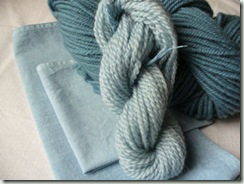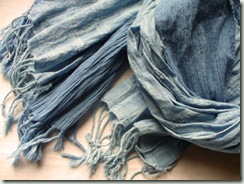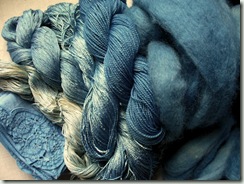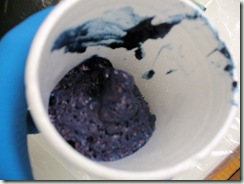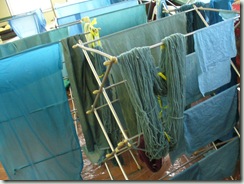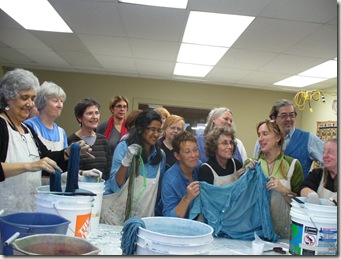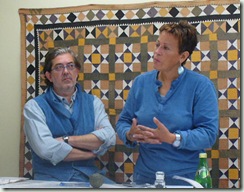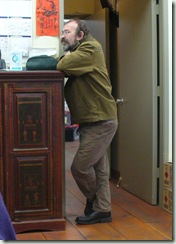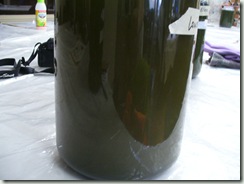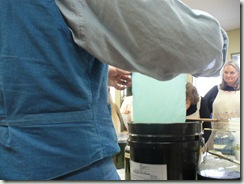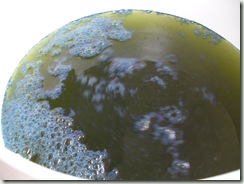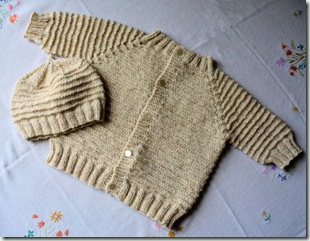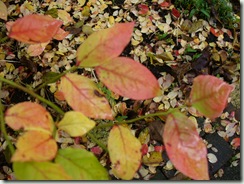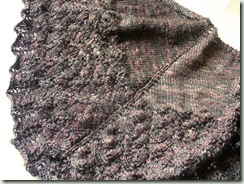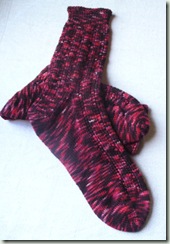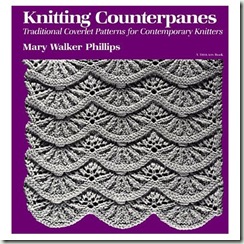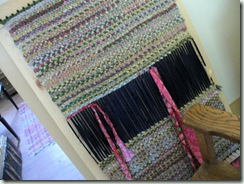Here’s my notes for the day after the workshop ended. I had my revived mother vat from the day before, all rested and ready to go.
Maiwa Symposium - Woad Workshop Notes: Day 2
Next morning I made up the main vat using half the amount of soda ash and thiox as we used in class. Then I poured in half of the mother vat and let it rest while I soaked my fibres. This time I had a set of 4 cotton napkins with tape lace edging, a skein of 6/2 silk that had been mordanted in alum for another project but came out somewhat brittle (I’ll use it for art quilting or something), a 50 g skein of Louet Gems fine fingering superwash wool yarn, a skein of 30/2 silk from The Silk Tree, a couple of tiny skeins of 5/2 natural cotton, and about 200 g of crossbred wool roving. I got good colour on everything except the little skeins of natural cotton yarn that I threw in at the last. They only got one dip and it was pretty wimpy so the yarn is blotchy and “interesting”. Everything else was fairly even except for the wool roving which I hadn’t spent time to unravel properly. It’ll make good yarn though.
Final Comments: I was a bit disappointed that Henri and Denise were not very encouraging about growing your own woad. They insisted that their product was of course superior to anything we could do in our own little garden and home. I showed some samples of my extraction woad and Denise immediately countered with her much darker samples! However, it’s not going to convince me to quit. I get blue, darn it! And their woad powder is $19.95 for a mere 30 g, enough for maybe two vats. Or $47.95 for 100 g, perhaps a more economical amount but larger initial outlay and Maiwa was all sold out of the larger containers when I went in with my symposium student’s 20%-off coupon that was burning a hole in my wallet. My home-grown woad costs very little except time and effort.
Another point of discussion is the second day’s addition of indigo to the woad vat. It did indeed increase the intensity while still keeping some of the characteristic softer colour of the woad though it was closer to that of indigo than woad by itself. I noticed that the fibres from the revived mother vat (Day 3) were even more indigo in appearance with less of the woad showing up. My thought is that the woad was pretty much depleted by that point. Even in powder form, woad is not as strong as an equal weight of indigo.
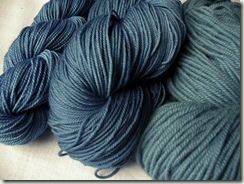 Here you can see wool skeins from each day, from right to left: Day 1, Day 2, Day 3. I think the woad-to-indigo colour shading difference is pretty obvious. Though the first skein is not bleached superwash and the other two are, which may make a difference. Judging by the final results, wool takes the dye much better than any other fibre. And woad is more muted turquoise than indigo blue.
Here you can see wool skeins from each day, from right to left: Day 1, Day 2, Day 3. I think the woad-to-indigo colour shading difference is pretty obvious. Though the first skein is not bleached superwash and the other two are, which may make a difference. Judging by the final results, wool takes the dye much better than any other fibre. And woad is more muted turquoise than indigo blue.
The suggestion is that for a good stable light- and wash-fast dye, 7 dips are optimal. These need only 5-10 minutes each with at least 15 minutes oxidizing in between. We were in too great of a hurry to give the fibres that many dips. The most I got was maybe 4 or 5 but I kind of lost count after awhile! Too many different items going in and out. Might behoove me to keep track in future though.
The sludge consists of tiny plant bits and other organic and non-organic molecules. It swells and sinks to the bottom and you don’t want to rile it up except in the case of reviving the mother vat. Let it settle and pour carefully so the majority of it stays in the bottom of the mother vat. The big vat gets very little of the sludge on the bottom of it. This helps avoid some of the staining problems that can happen when the fibre rests on the sludge. It’s similar to Maiwa’s indigo recipe and the “stock solution”.
Final results of Day 1, bottom of stack to top: cotton napkin, cotton napkin quarter (test piece), wool yarn (overnight in vat), wool yarn.
Total weight: 183 g.
Final results of Day 2, bottom of stack to top: natural linen/rayon (variegated dips), silk habotai, bleached cotton, bleached linen (test piece), sock yarn (superwash wool/nylon).
Total weight: 342 g.
Final results of Day 2, continued: handwoven cotton scarves, lighter one had 2 dips and darker crinkle one had 4.
Total weight: 181 g
+ the 342 g from previous = 523 g
Final results of Day 3, bottom to top: cotton napkins with tape lace edging, 5/2 mercerised unbleached cotton yarn, 30/2 bombyx silk, 6/2 bomby silk, 2-ply superwash wool, wool roving.
Total weight: 542 g
Everything was eventually rinsed and then washed in warm water with a little Synthrapol: fabrics in the washing machine on gentle and skeins by hand. Some things needed only a little rinsing for the water to come clear and others needed several more changes of water. I dried the cottons in the dryer and hung the others on the line. All the fabrics were pressed with a hot iron (not too hot in the case of the silk) and the silk skeins were “whapped” a few times on the counter to soften them.
And that’s the story of my Woad Workshop adventures!
Happy Halloween!! How do you like my costume?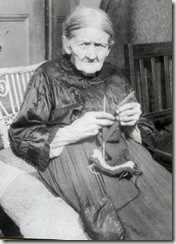
I’m the Knitting Granny! Mwaahhhh-ha-haaaaa!!!!
